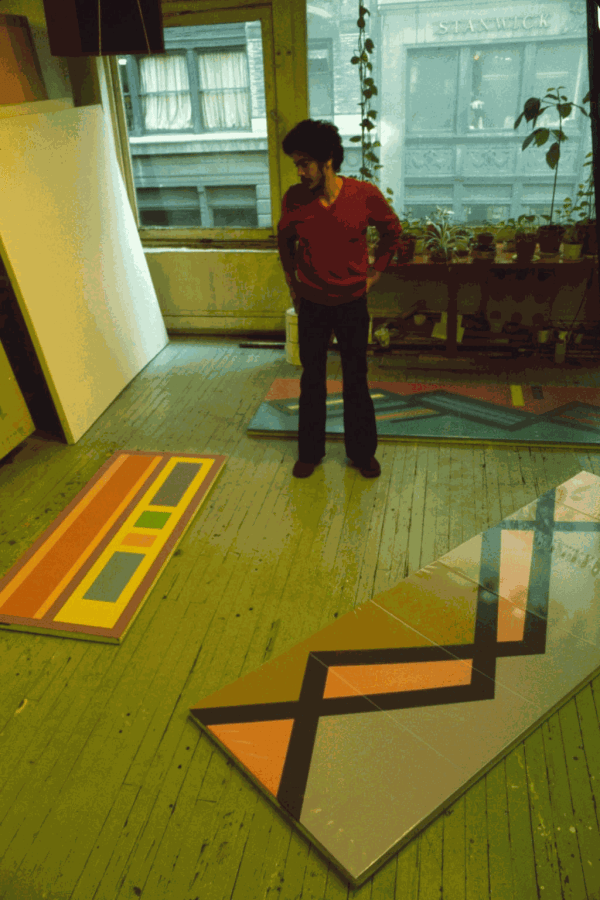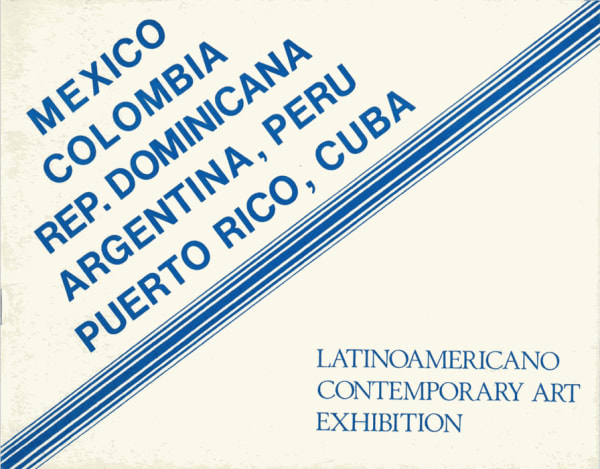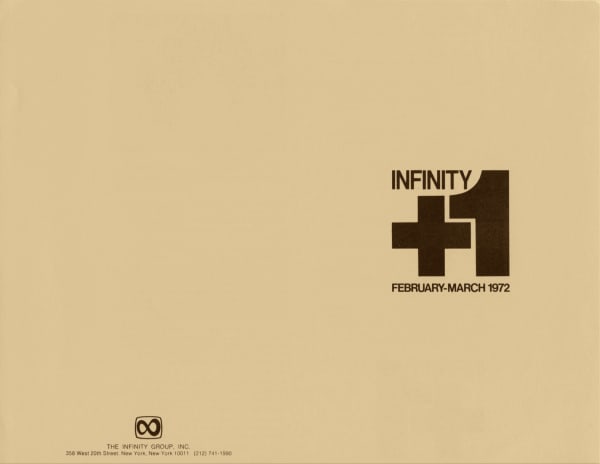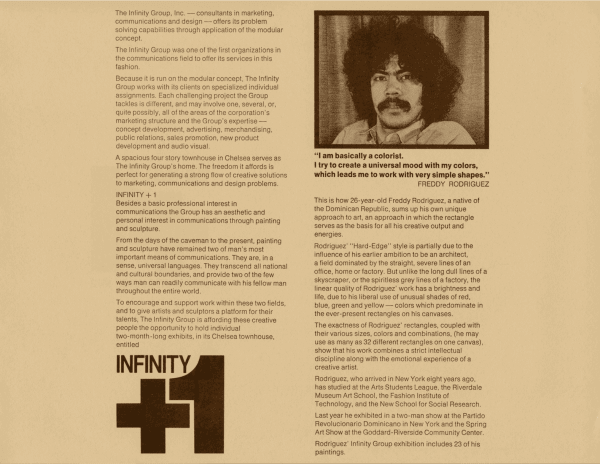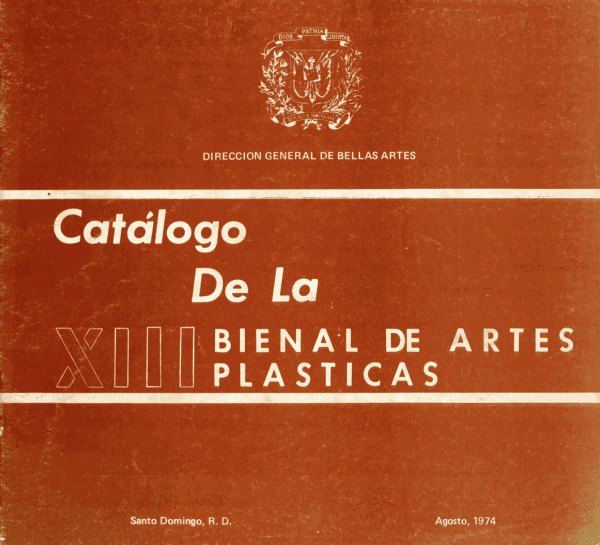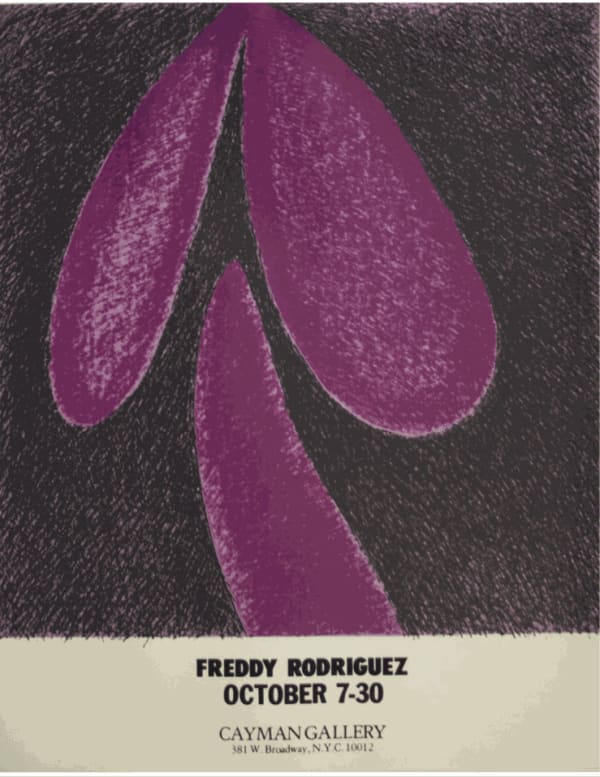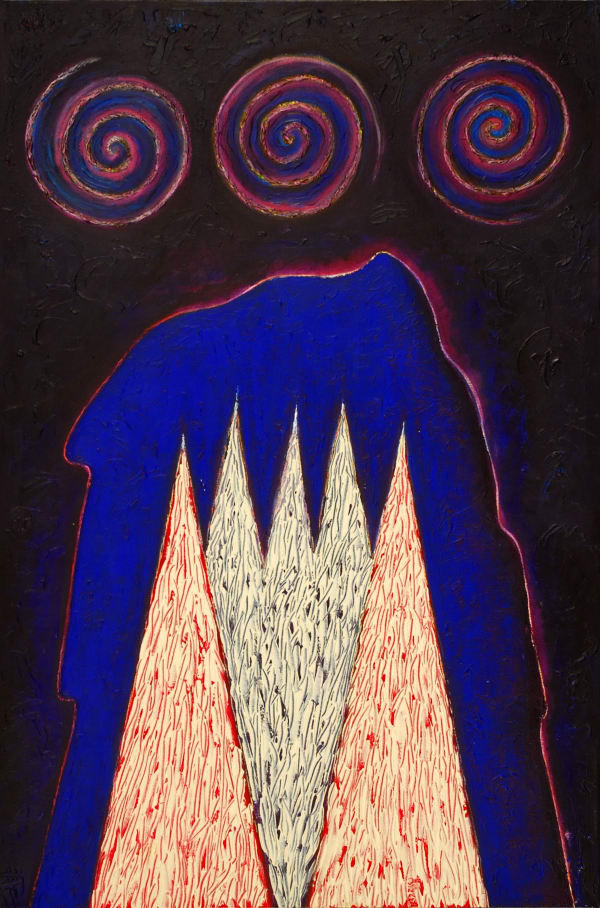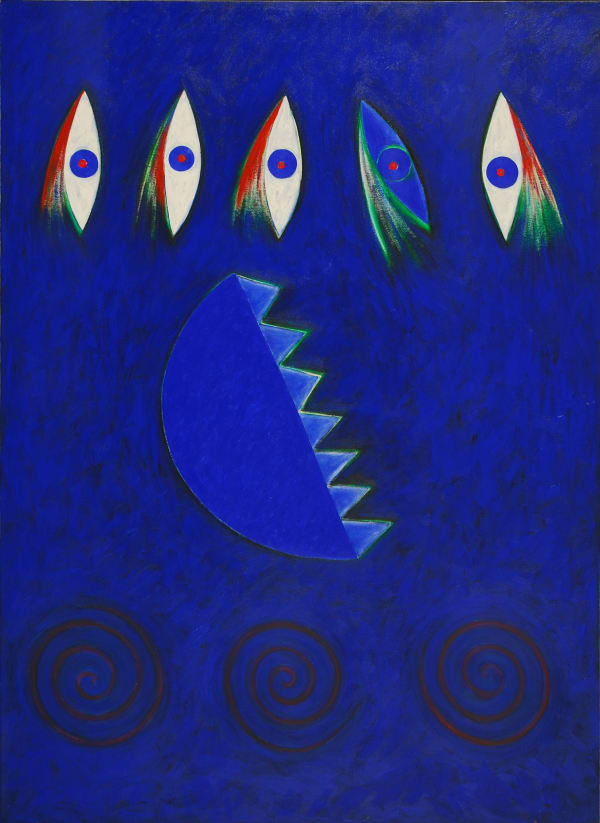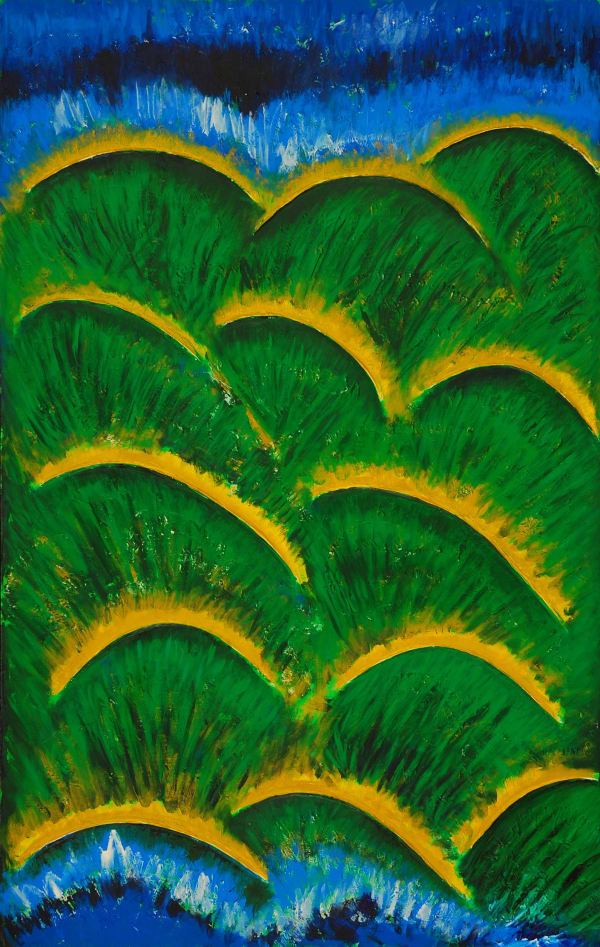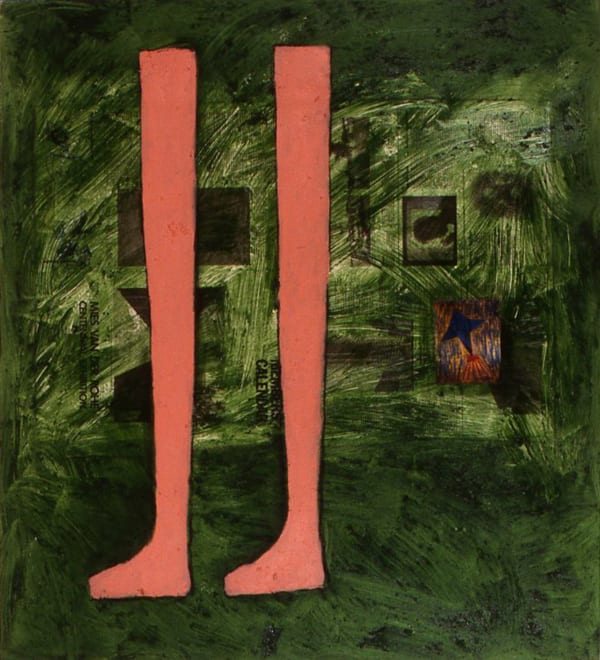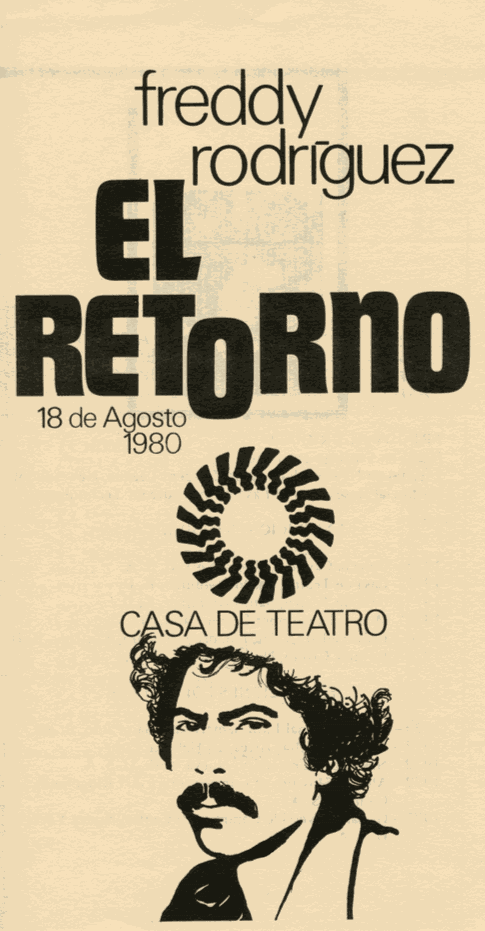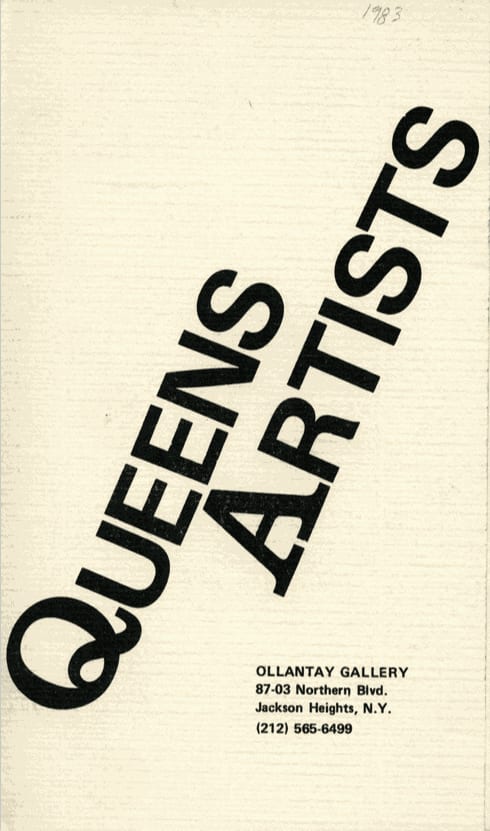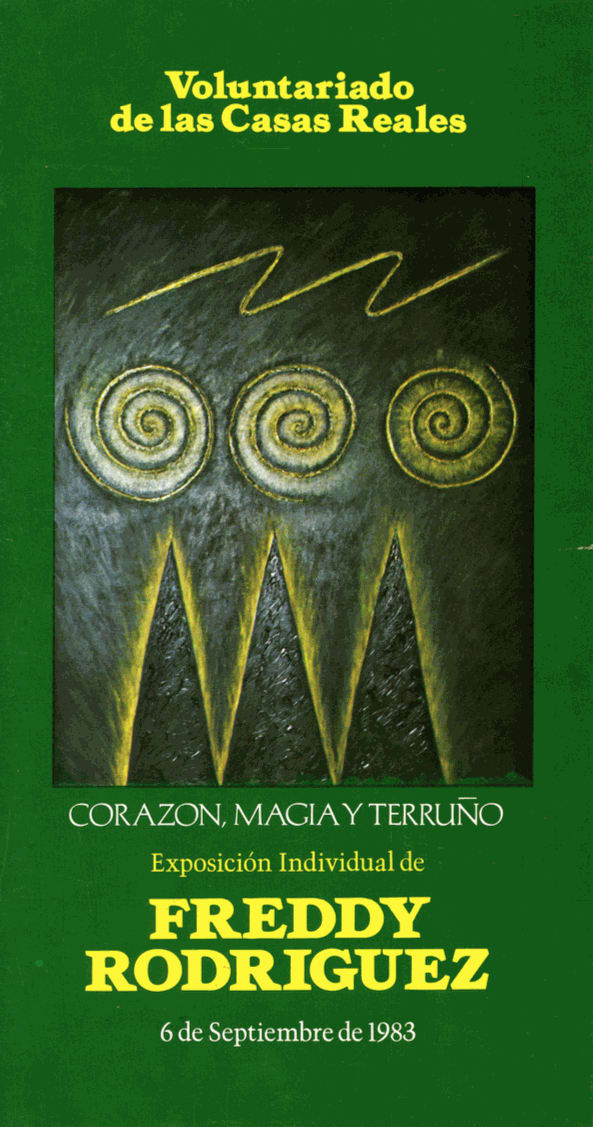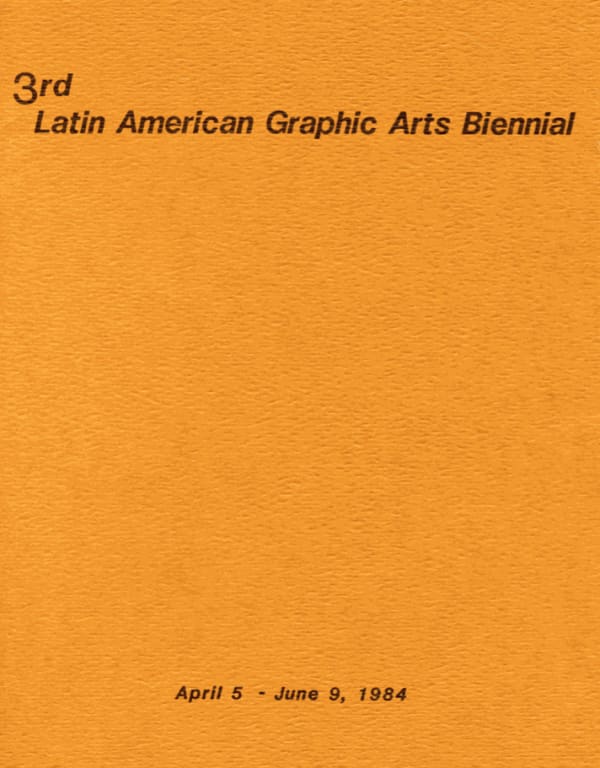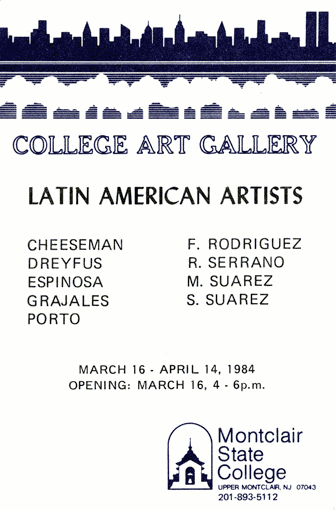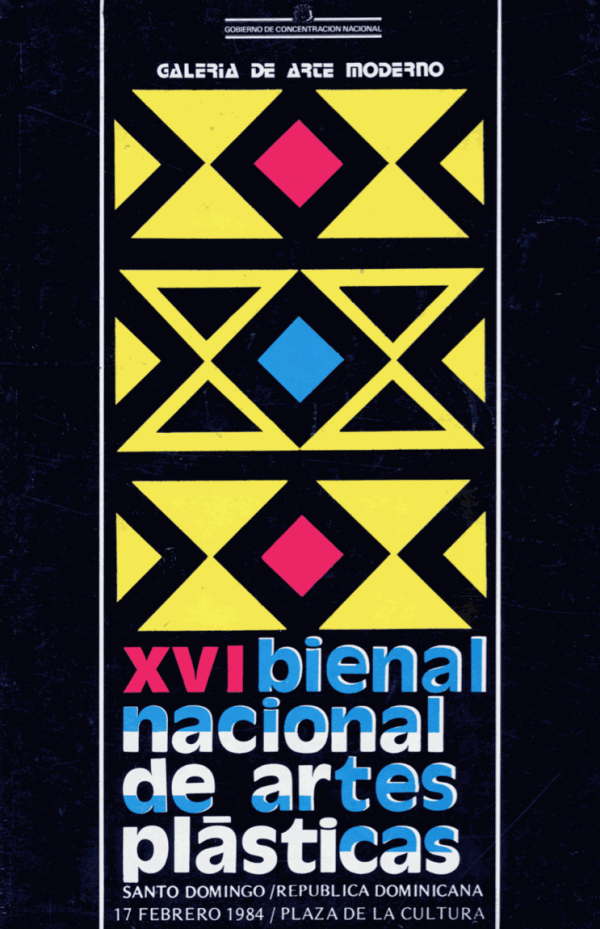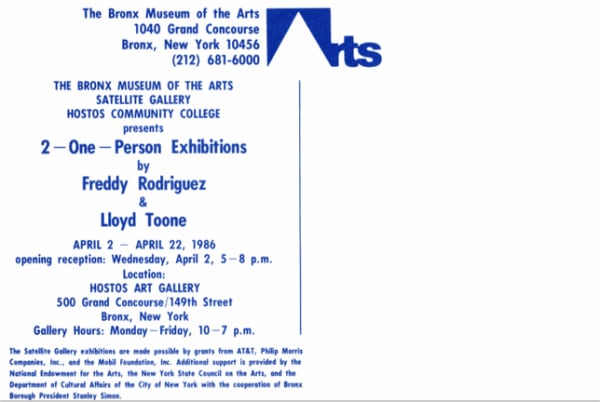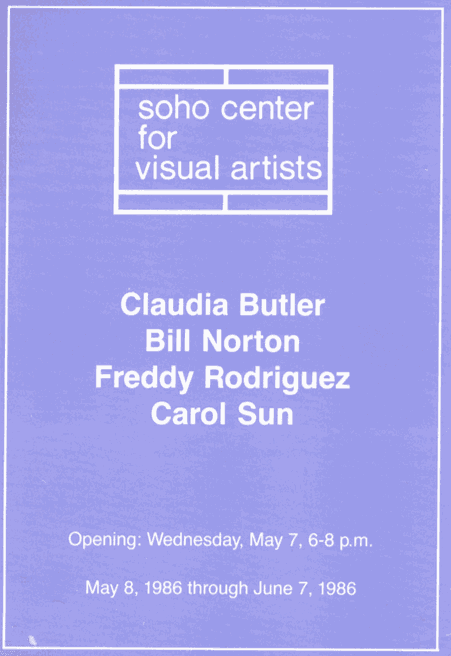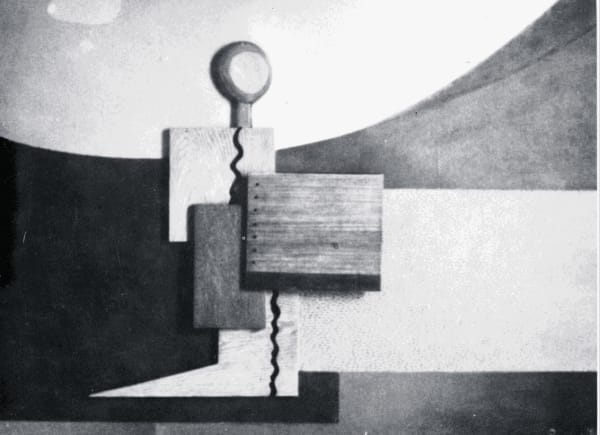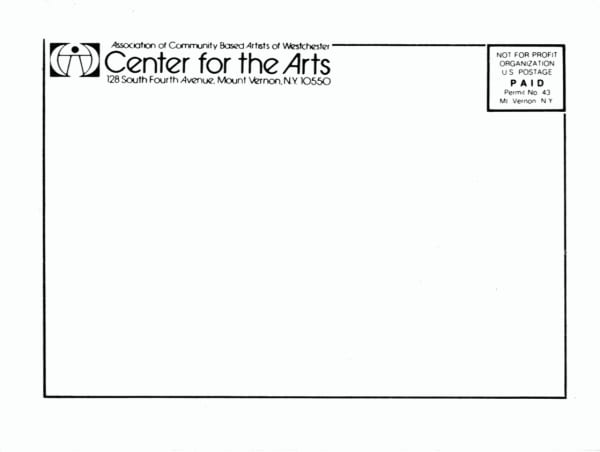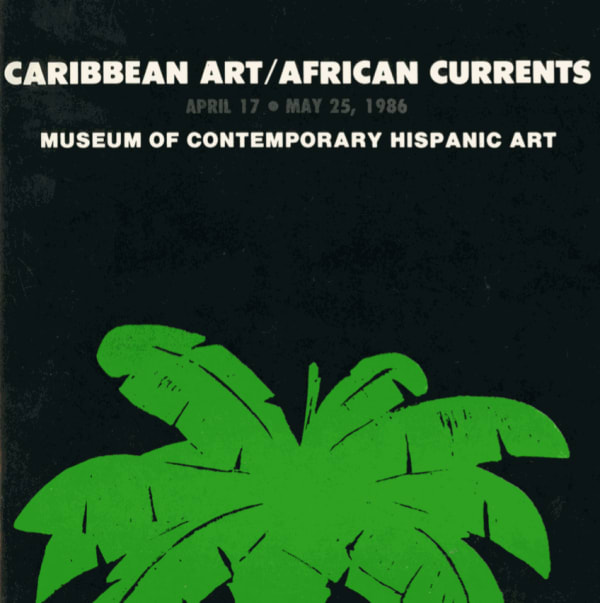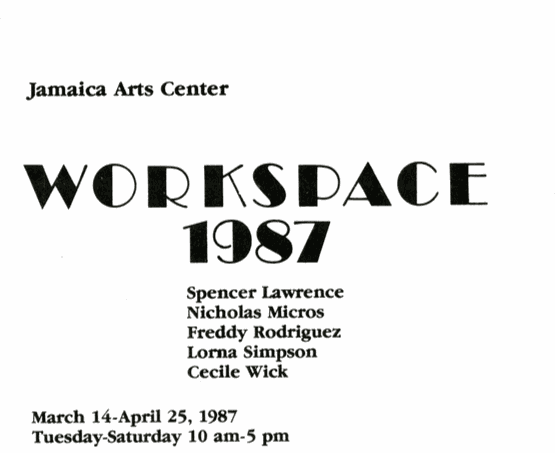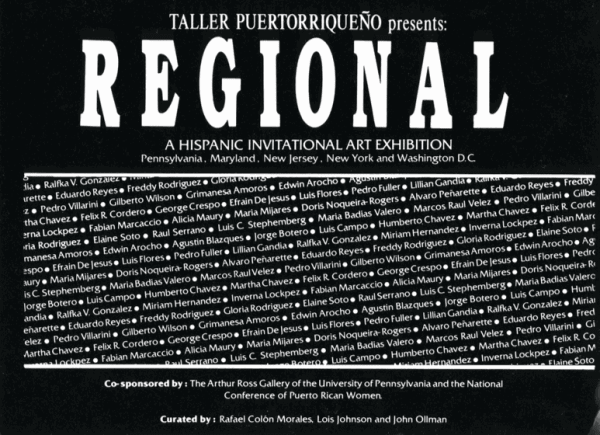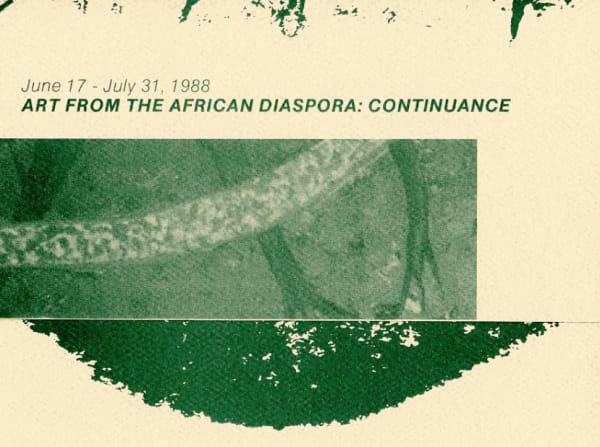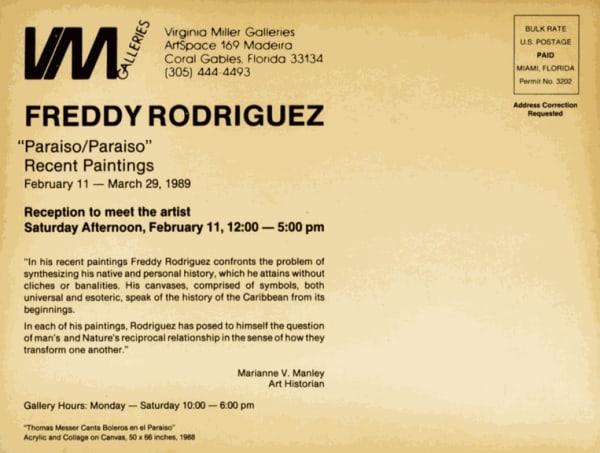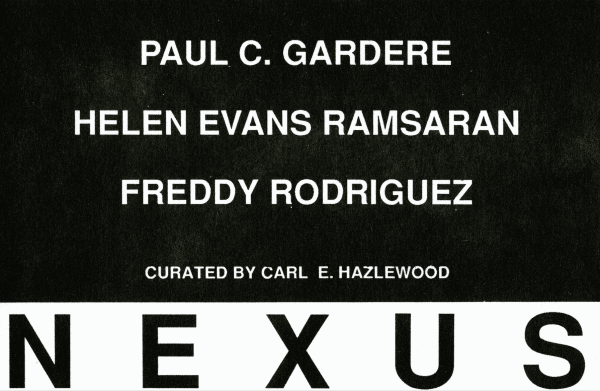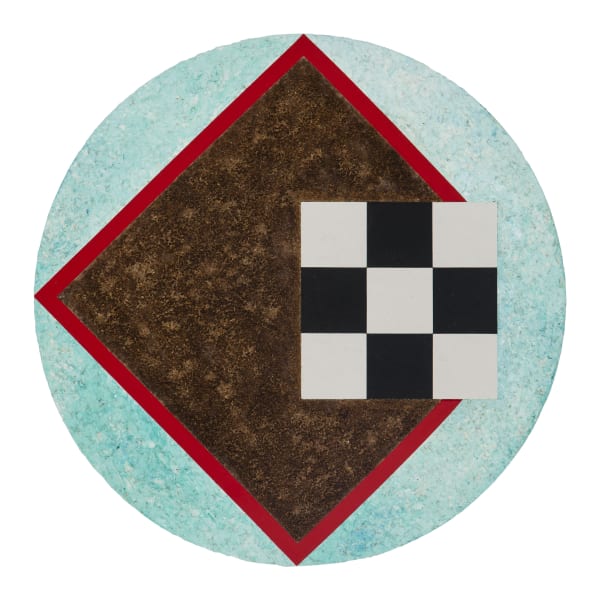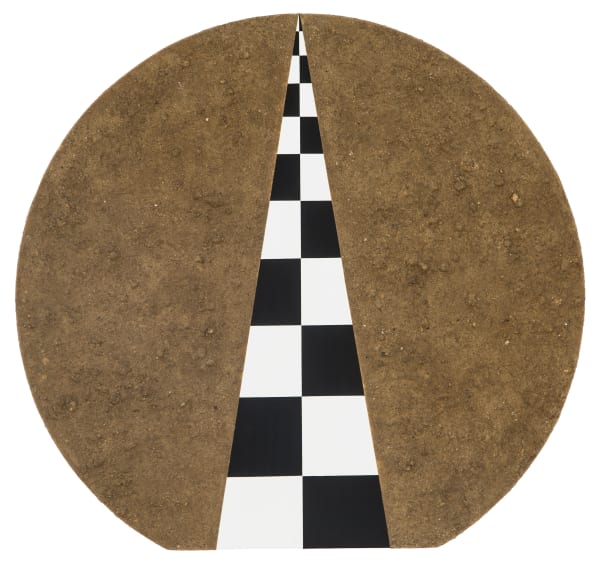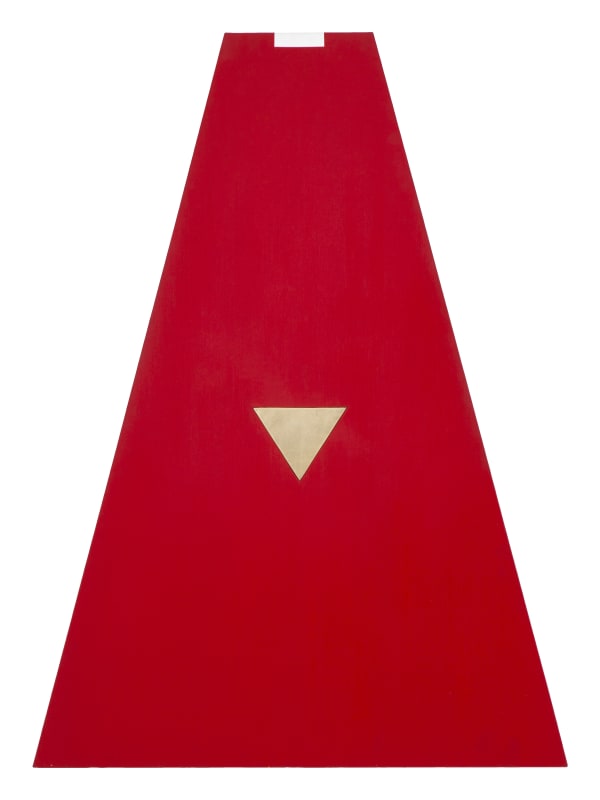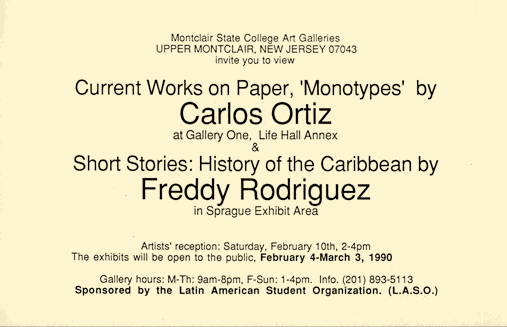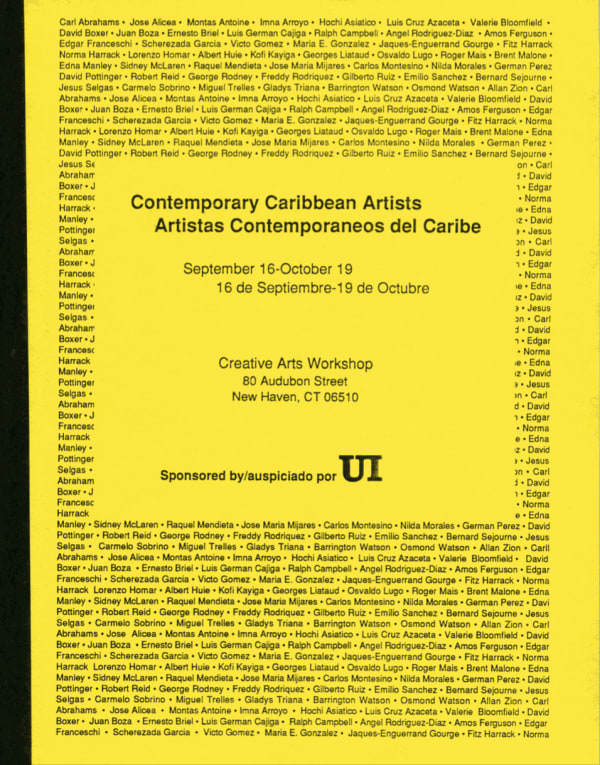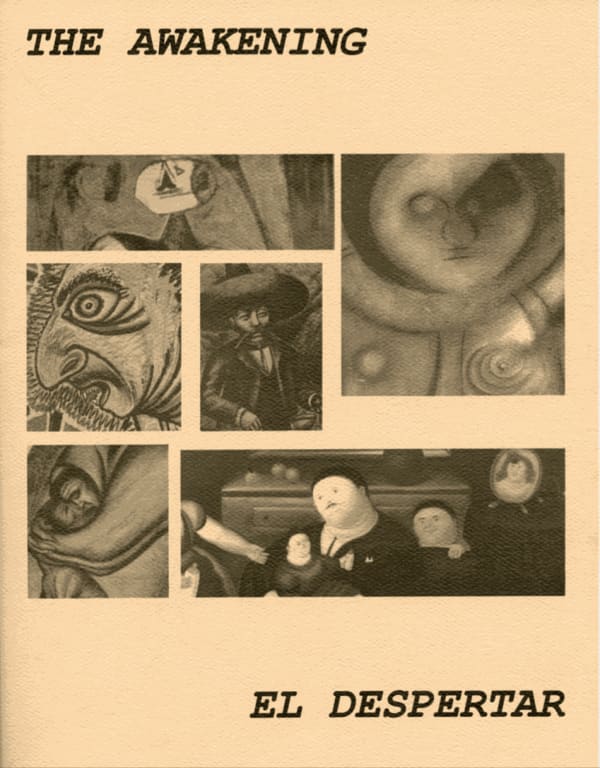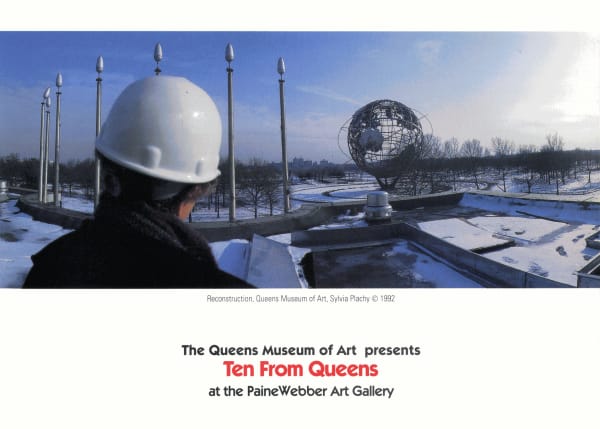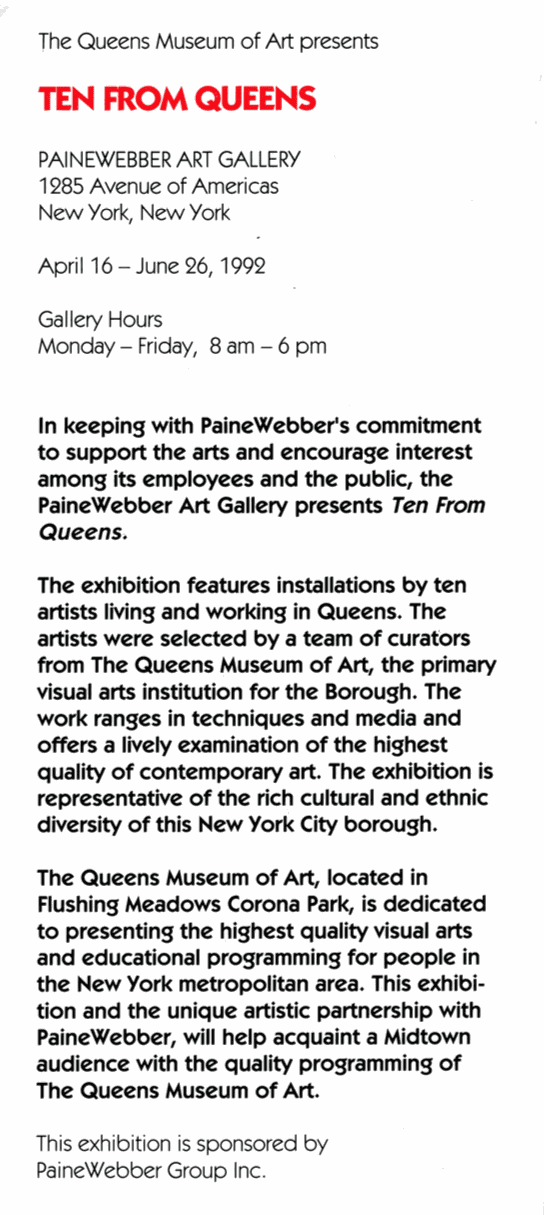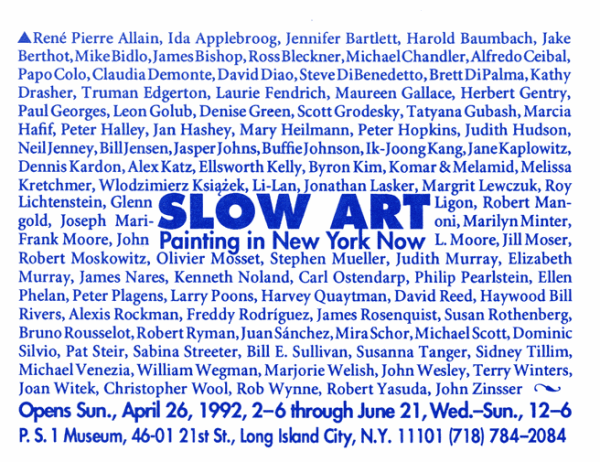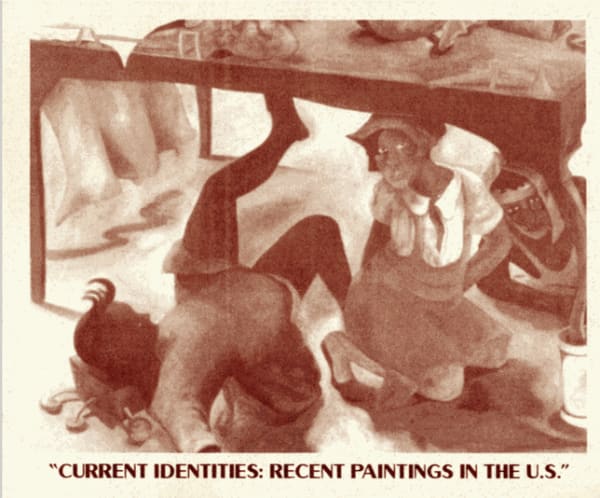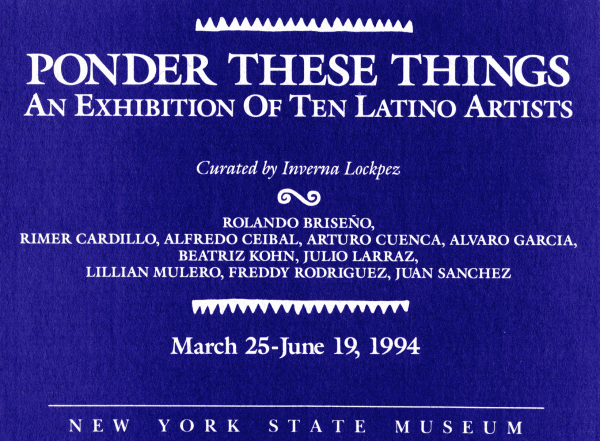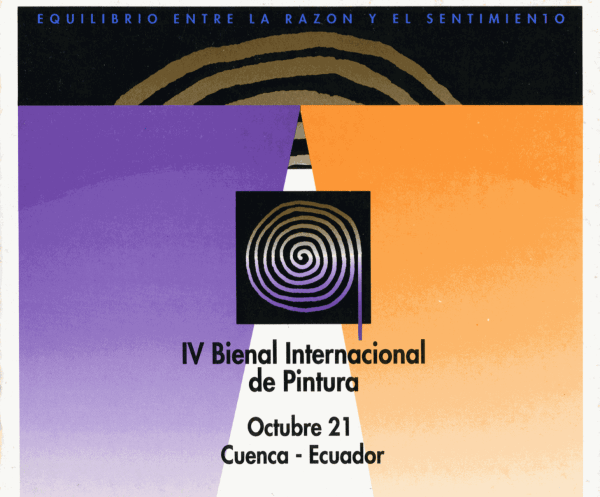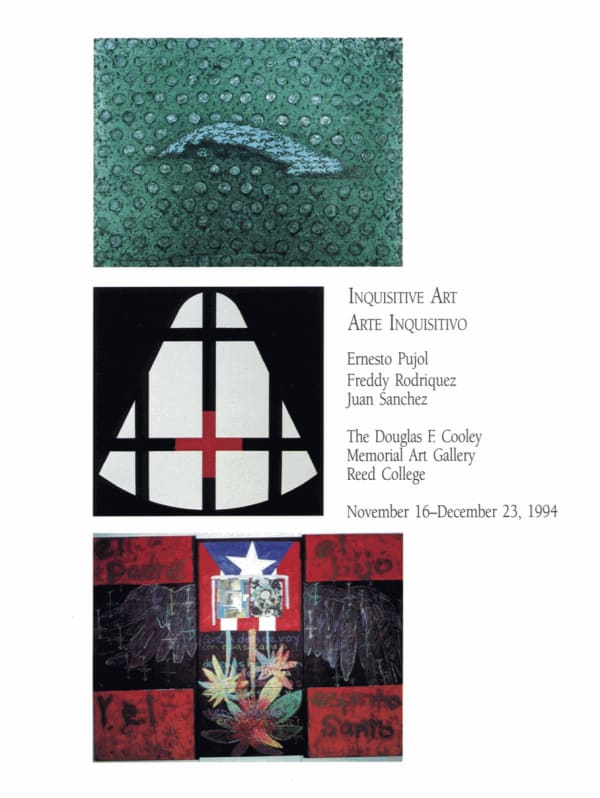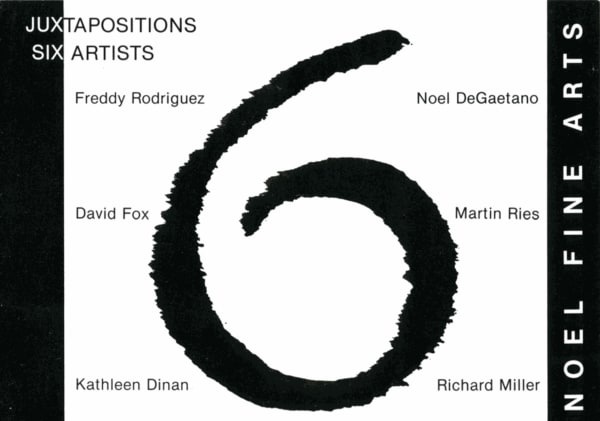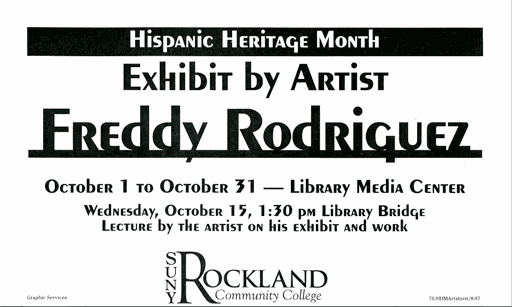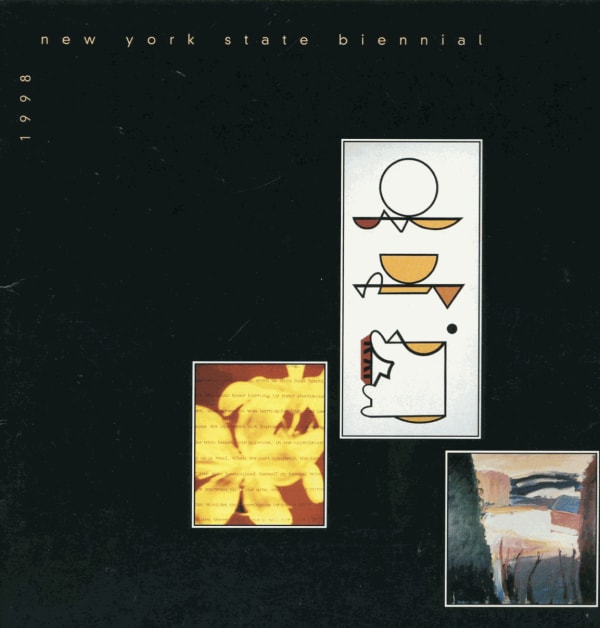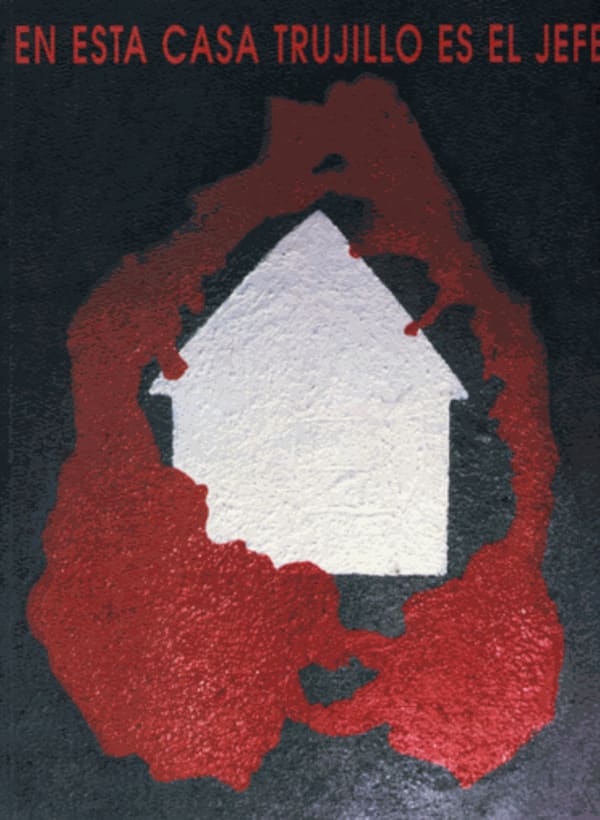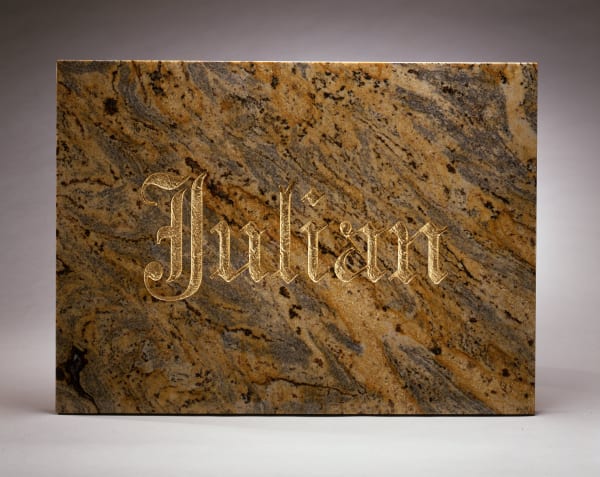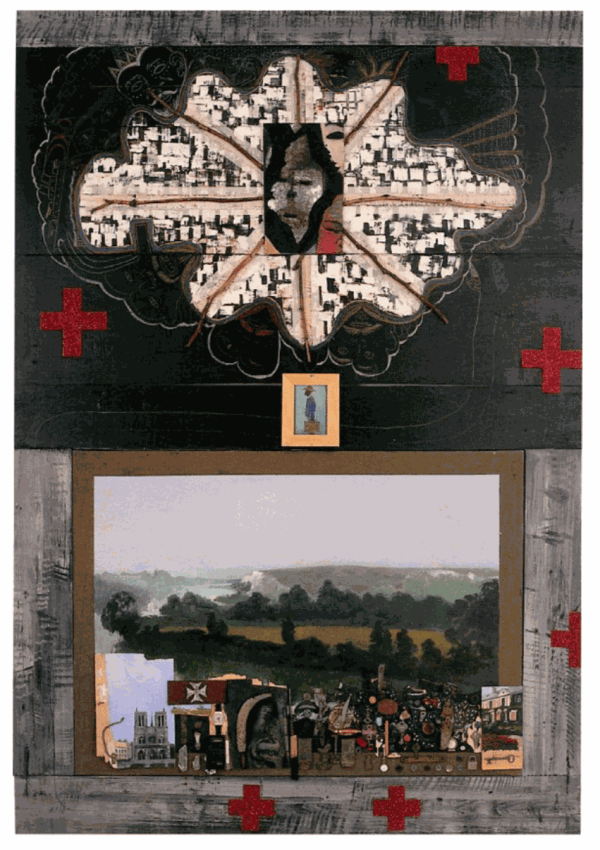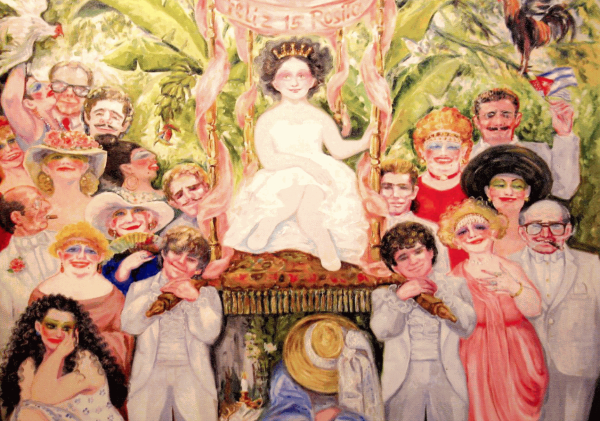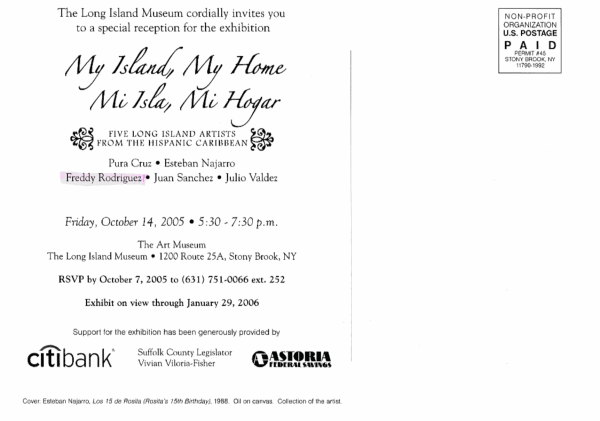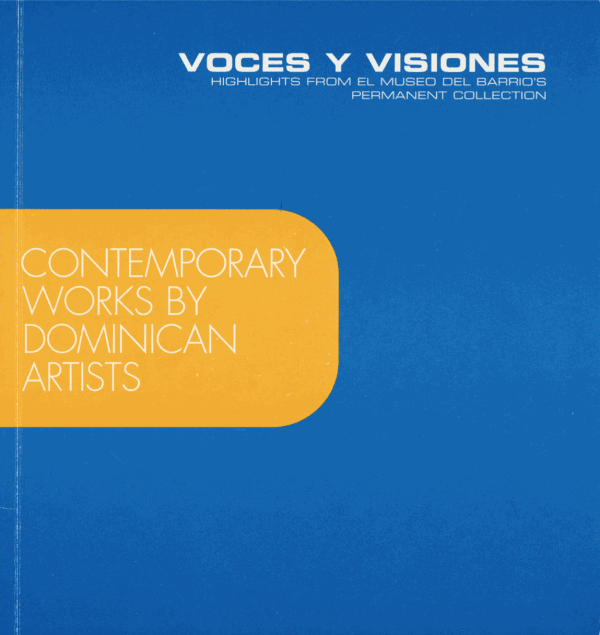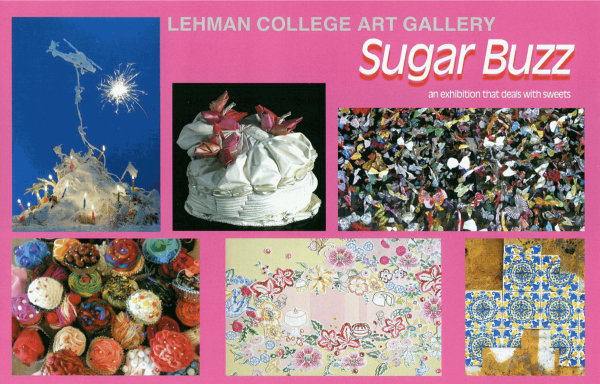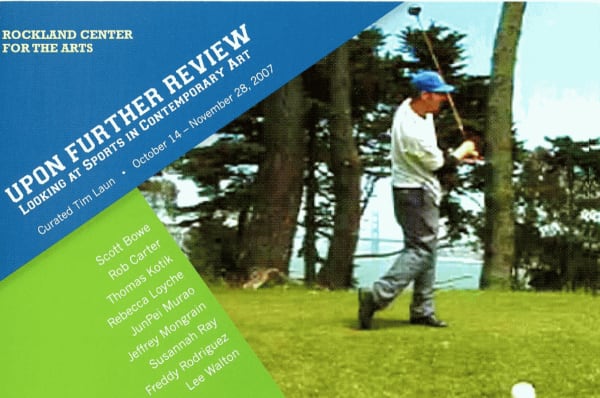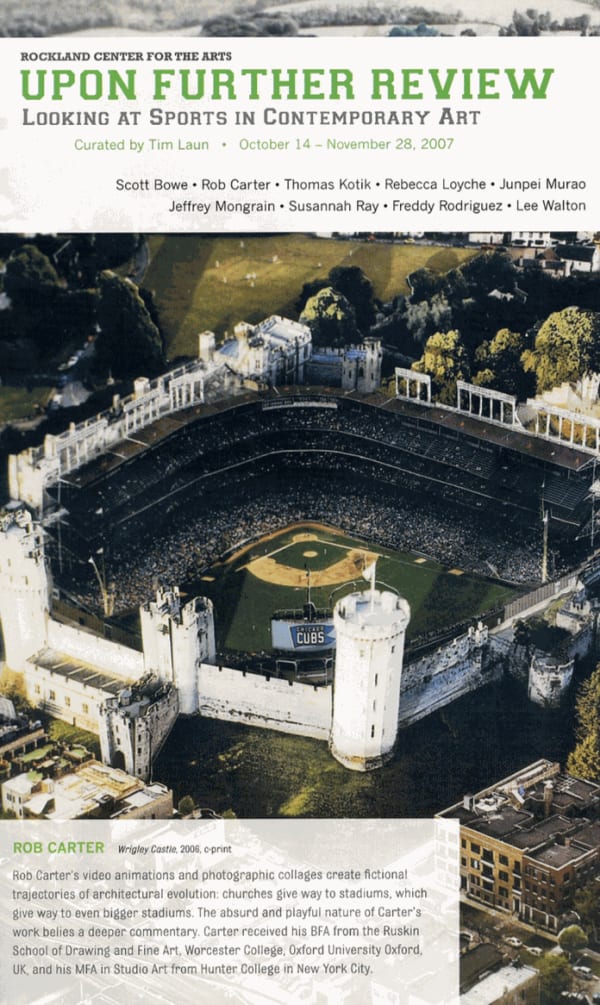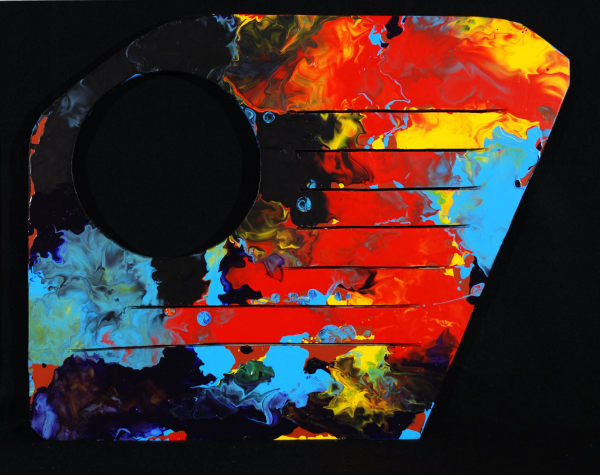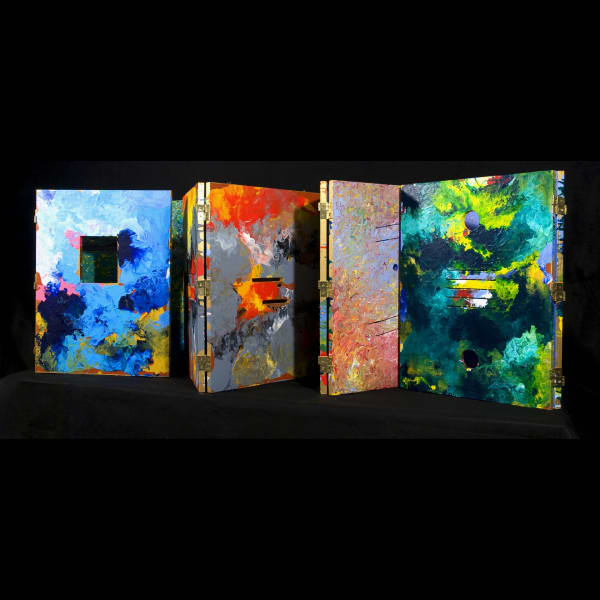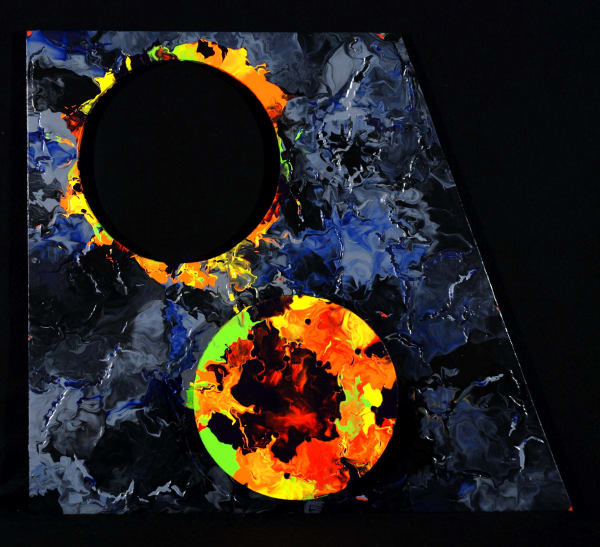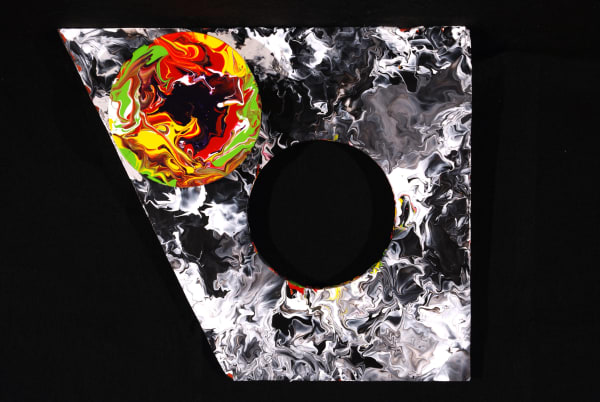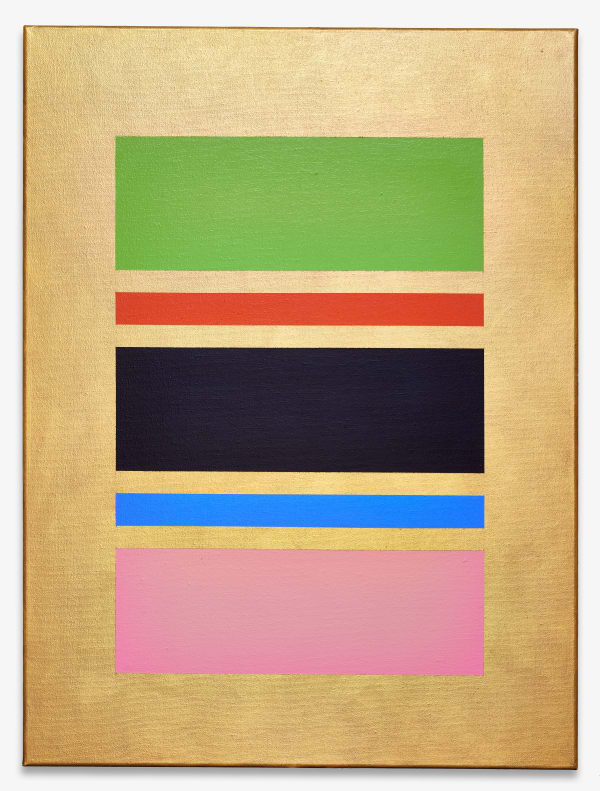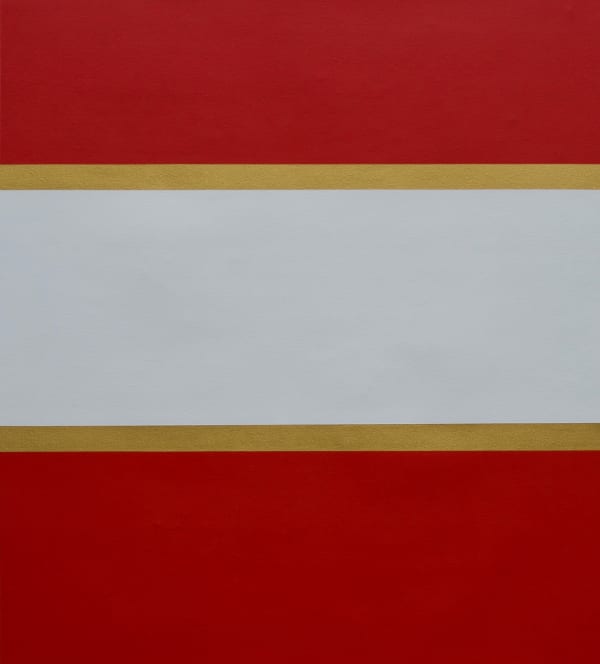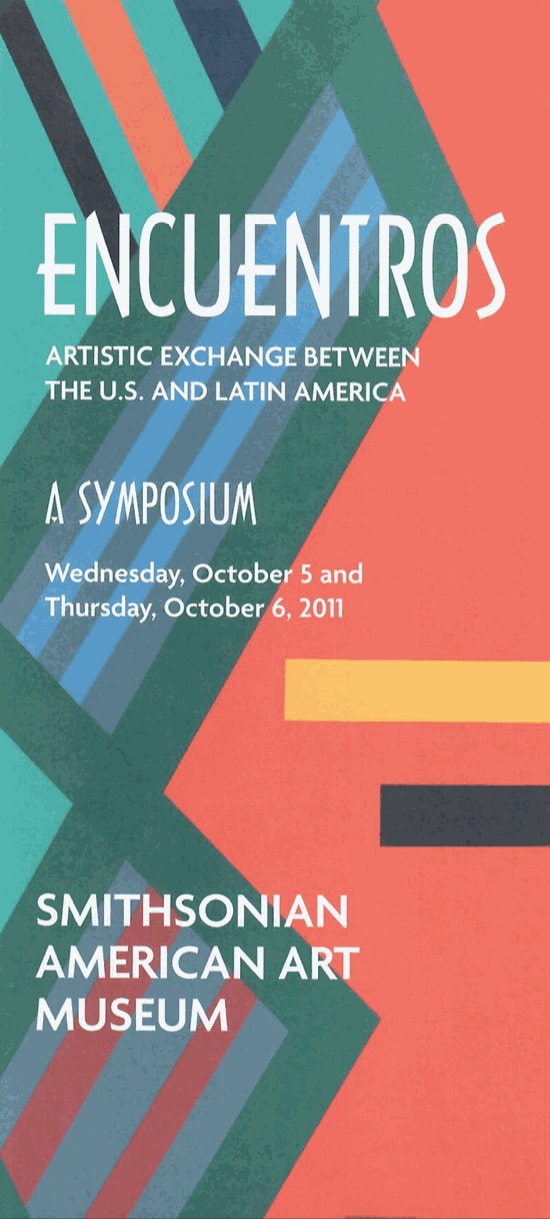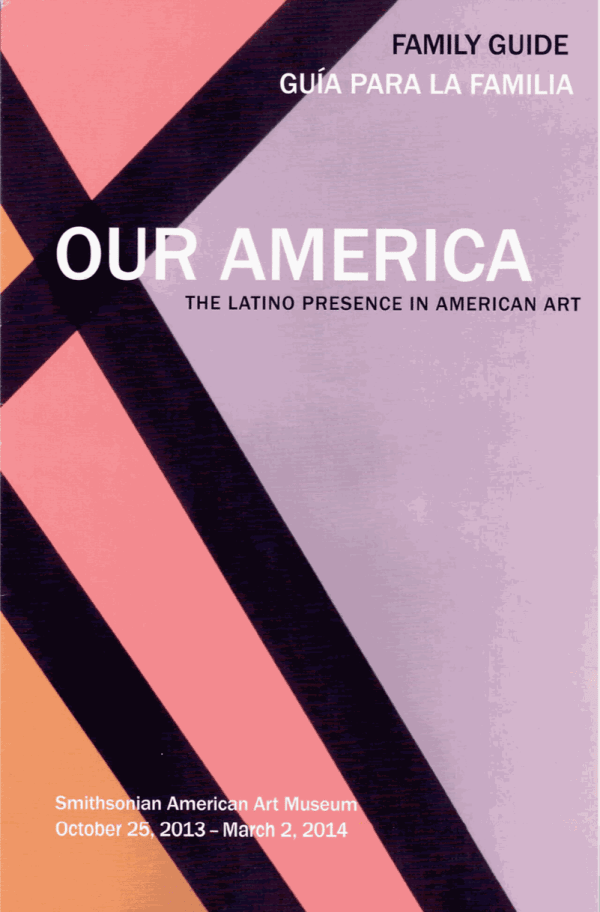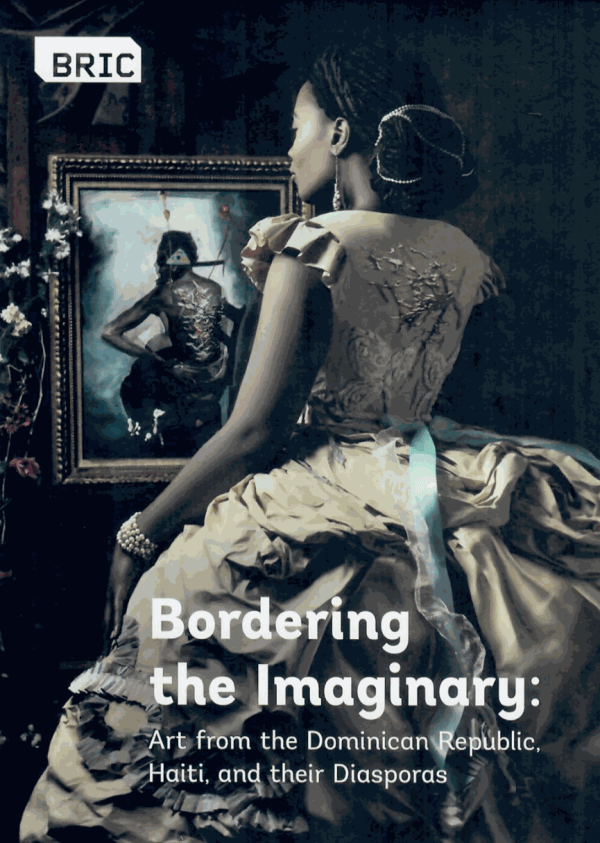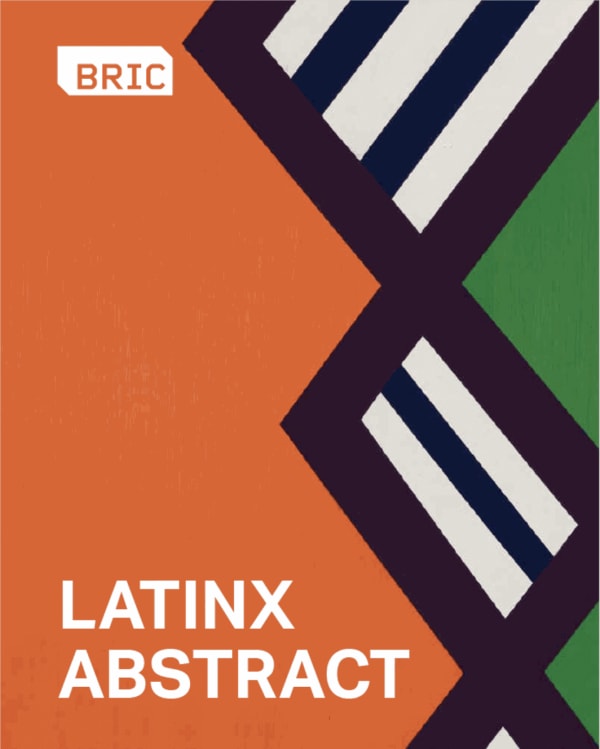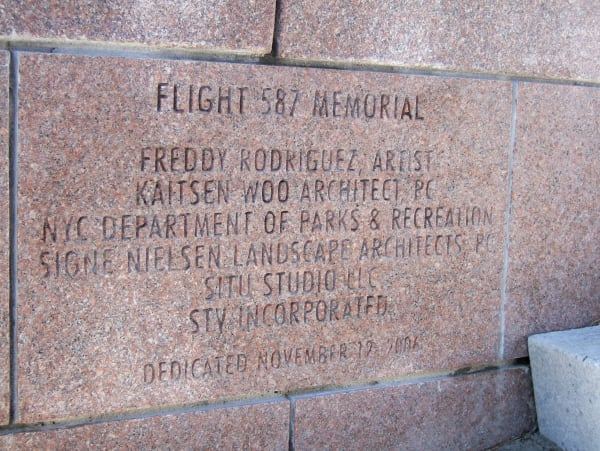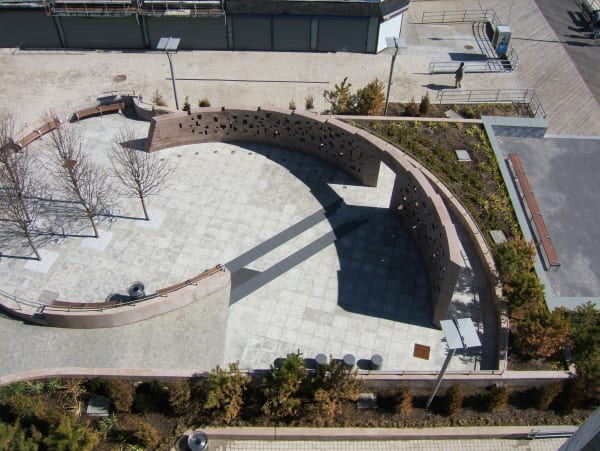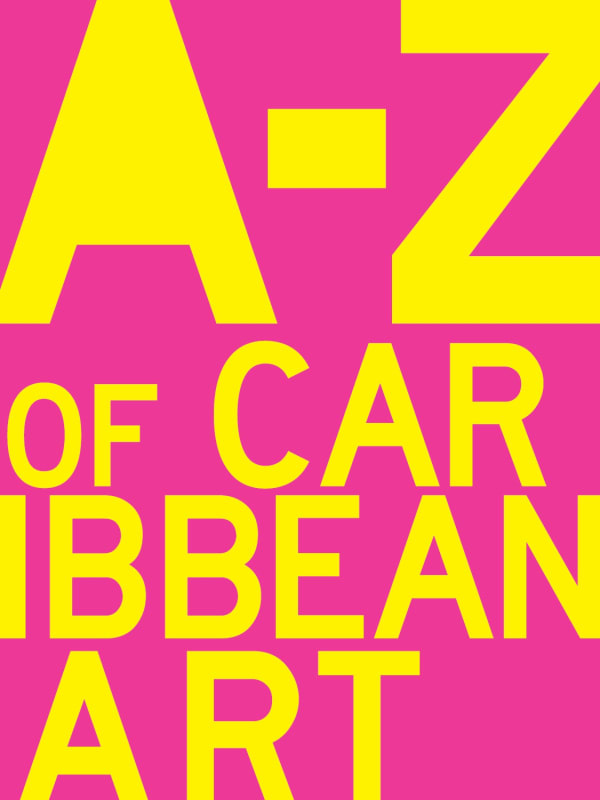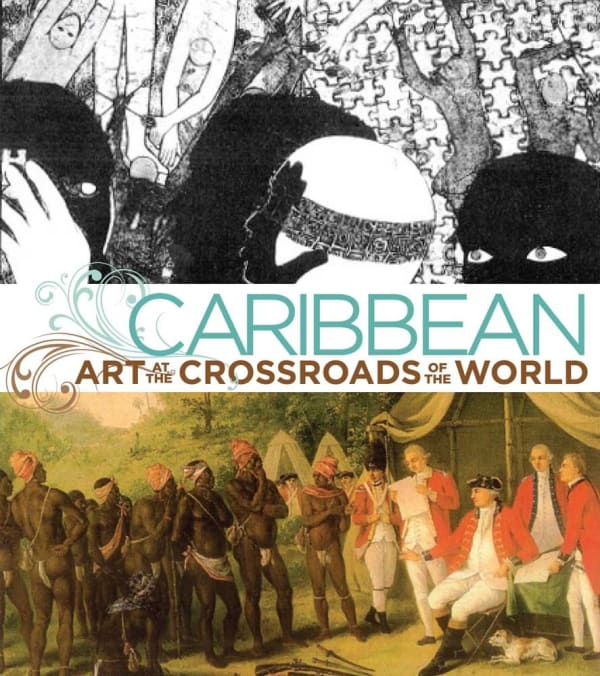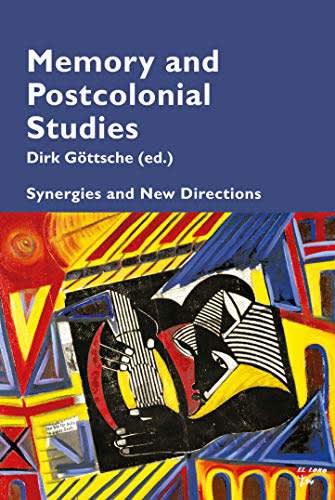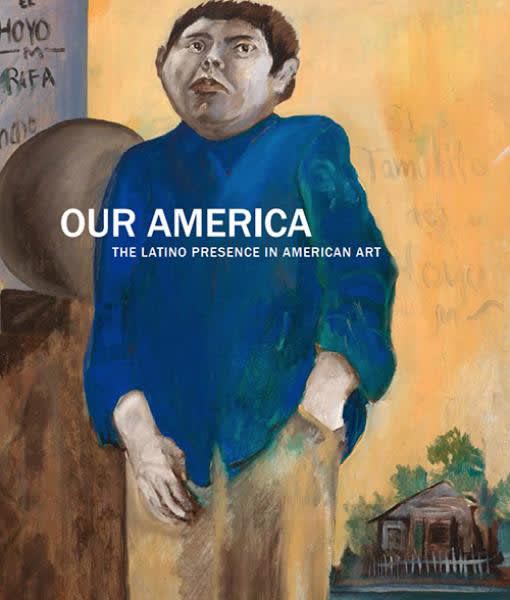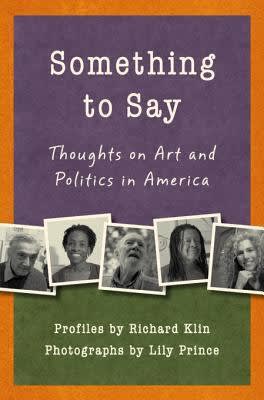-

Freddy Rodríguez in his Flushing, NY studio, by Manolo Salas, 2016
-

Freddy Rodríguez photographed in his studio in Queens, NY, by Manolo Salas, 2016
-
Working in Series
Throughout his career, Rodríguez worked in "series." His first and longest series was Geometries, which he began in the late 1960s and continued to expand and develop until the early 2000s.
“In 1969, while at FIT I did my first Geometric paintings. I still have some of these paintings. These paintings were informed by the architecture of the city. I had a job downtown and during my lunch hour I would sketch the buildings around me and later turn them into paintings.”
Rodríguez in conversation with Rocío Aranda-Alvarado (2015)
-

Left to Right: Amor Africano, 1974 Danza Africana, 1974 Danza de Carnaval, 1974
Smithsonian American Art Museum, Washington, D.C.
-
Freddy Rodríguez | Latinx Abstract Artists 2021
BRIC -
Rodríguez in his Chelsea Studio, New York, 1974
-
"When I was attending high school, my art teacher gave me a pass to MoMA. That really was very important. I wasn't familiar with the collection, I had never seen abstract art, or original abstract art. And I fell in love with abstraction right away, especially geometric abstraction." - Freddy Rodríguez
-

-
Selected 1970s Exhibitions
-

Goddard-Riverside Community Center, Spring Art Show 1971 New Images - West Side, New York, 1971 (Cover)
-

Goddard-Riverside Community Center, Spring Art Show 1971 New Images - West Side, New York, 1971
-

Contemporary Arts Gallery, Loeb Student Center, New York University, Mexico, Colombia, Rep. Dominicana, Argentina, Peru, Puerto Rico, Cuba: Latinoamericano Contemporary Art Exhibition, New York, 1972
-

Infinity +1, New York, 1972 (Cover)
-

Infinity +1, New York, 1972
-

Palacio des Bellas Artes, XIII Bienal de Artes Plasticas, Santo Domingo, Dominican Republic, 1974
-

Museo del Hombre Dominicano, Primera Exposicion Individual en Santo Domingo, Santo Domingo, Dominican Republic, 1974
-

Casa de Teatro, 2da. Exposicion Individual, Santo Domingo, Dominican Republic, c. 1977
-
-

Bura Bura, 1981, 42 x 58 in
Private Collection, Madrid, Spain
-

El Corazon del Quijote, 1982, 70 x 48
-
Symbolism Series (1983-1985)
-

Paradise for a Tourist Brochure, 1990, 66 x 60 in
National Gallery of Art, Washington, D.C.
-
Fireworks Series (1984-1985)
-

El Cimarrón Y La Comedia Divina, 1986, 44 x 40 in
Private Collection, New York, NY
-

Cosas del Paraíso, 1989, 60 x 42 in
Private Collection, Princeton, NJ
-
Selected 1980s Exhibitions
-

Casa de Teatro, El Retorno, Santo Domingo, Dominican Republic, 1980
-

Castle Gallery, 14 Contemporary Latin American Artists, New Rochelle, NY, 1981
-

Cayman Gallery, Freddy Rodríguez, New York, 1982
-

Alternative Museum, Sacred Artifacts Objects of Devotion, New York, 1982
-

OLLANTAY Center for the Arts, Queens Artists, New York, 1983
-

Voluntariado de las Casa Reales, Corazon, Magia y Terruno, 1983
-

Queensborough Community College Gallery, Works on Paper, New York, 1983
-

Cayman Gallery, 3rd Latin American Graphic Arts Biennial, New York, 1984
-

Monclair State College, Latin American Artists, NJ, 1984
-

City Gallery, Dominican Visual Artists of New York, New York, 1984
-

Galeria de Arte Moderno, XVI Bienal Nacional de Artes Plasticas, Santo Domingo, Dominican Republic, 1984
-

Goddard-Riverside Community Center, Carribean Art: African Currents, New York, 1985
-

El Museo del Barrio, New York, NY, San Antonio Museum of Art, San Antonio, TX, Plaza de la Raza, Los Angeles, CA, The Canadian Club Hispanic Art Tour, 1984
-

The Bronx Museum of the Arts, Freddy Rodriguez Painting/Lloyd Toone Sculpture, New York, 1986
-

SOHO Center for Visual Artists, New York, 1986
-

Center for the Arts, Artistas Latinos, Mount Vernon, NY, 1986 (Cover)
-

Center for the Arts, Artistas Latinos, Mount Vernon, NY, 1986
-

Museum of Contemporary Hispanic Art (MoCHA), Carribbean Art/African Currents, New York, 1986
-

America 500: Attitude Art, New York, 1986
-

America 500: Attitude Art, New York, 1986
-

Jamaica Arts Center, Workspace 1987, New York, 1987
-

Taller Puertorriqueno, Regional: A Hispanic Invitational Art Exhibition, MD, PA, NJ, NY, & Washington, D.C., 1987
-

Aljira A Center for Contemporary Art, Art from the African Diaspora: Continuance, New York, 1988
-

Boinayel, Galeria de Arte y el Instituto Dominicano de Cultura Hispanica, Santo Domingo, Dominican Republic, 1988
-
-
"Freddy Rodriguez’s enigmatic paintings challenge the spectator to peer “below the surface” both literally and metaphorically, and to question the contradictions posed by his disparate subject matter. He developed his complicated pictorial means – combining different painting styles and collage elements within each work, as well as juxtaposing still life subjects, symbols, geometric forms and found texts – in response to his intent: For several years Rodriguez’s project has been a personal, visual interpretation of the history of the Caribbean world, prior to 1492 and continuing to this day. He offers the possibility to sense the effects of historical events in a way that more traditional vehicles of recording the past like newspaper articles, scholarly works, even photographs, are incapable of providing. In these works are elegies for times, values, and opportunities lost, they do not lack hope. Their power is derived from their ability to convey truth and in the spaces they create for imagining."
Elizabeth Ferrer April 1990
For the Scott Alan Gallery "New Paintings by Freddy Rodriguez"
-

Casabe y Cruz II, 1991, 48" diameter
National Gallery of Art, Washington, D.C.
-

Casula, 1993, 24 x 34 in
-

-
Selected 1990s Exhibitions
-

Erector Square Gallery, Breaking Boundaries, New Haven, CT, 1990
-

Montclair State College, Short Stories, Upper Montclair, NJ , 1990
-

Scott Alan Gallery, Paradise: New Paintings by Freddy Rodríguez, New York, 1990 (Cover)
-

Scott Alan Gallery, Paradise: New Paintings by Freddy Rodríguez, New York, 1990
-

The Discovery Museum, The Awakening, New York, 1990
-

The Queens Museum, Queens 1990, New York, 1990-91
-

Creative Arts Workshop, Contemporary Caribbean Artists, New Haven, CT, 1991
-

The Discovery Museum, The Awakening, New York, 1991-92 (Cover)
-

The Discovery Museum, The Awakening, New York, 1991-92
-

PaineWebber Art Gallery, Ten From Queens, New York, 1992
-

Queens Museum, Ten From Queens, New York, 1992
-

P.S. 1 Museum, Slow Art, New York, 1992
-

Lehman College Art Gallery, Contemporary Public Art in the Bronx, New York, 1993
-

La Embajada de los Estados Unidos de America y El Museo de Arte Contemporaneo, Current Identities, 1993
-

New York State Museum, Ponder These Things: An Exhibition of Ten Latino Artists, Albany, NY, 1994
-

IV Bienal Internacional de Pintura, Cuenca, Ecuador, 1994
-

Douglas F. Cooley Memorial Art Gallery, Inquisitive Art, Portland, OR, 1994
-

Aljira A Center for Contemporary Art, Vienen Por Las Islas, Newark, NJ, 1994
-

Nöel Fine Arts, Juxtapositions: Six Artists, Bronxville, NY, 1995
-

Jersey City Museum, Freddy Rodríguez Priests: The Spirit and the Flesh, NJ, 1995
-

New Rochelle Library, Spectrum: Visions of Latin American Artists, New Rochelle, NY, 1996
-

INTAR Gallery, Art in Transit: A Dominican Experience (Part One), New York, 1996
-

INTAR Gallery, Art in Transit: A Dominican Experience (Part Two), New York, 1996
-

Queens Museum of Art, Queens Artists: Highlights of the 20th Century, New York, 1997
-

SUNY Rockland Community Center, Freddy Rodríguez, Suffern, NY, 1997
-

New York State Museum, New York State Biennial, Albany, NY, 1998 (Cover)
-

The Korn Gallery, Cross Purpose: Traditional Symbol/Contemporary Visions, Madison, NJ, 1999
-

Jersey City Musuem, En Esta Casa Trujillo es el Jefe, NJ, 1999-2000
-
-

Best Doctors #4, 2000
-

A-Rod Six of Thirteen, 2007, 40 x 40 in
National Portrait Gallery, Smithsonian Institution
-
-

Julian Apostol, 2005, 20 x 30 x 1 1/4 in
Etched Amarillo Jaguar granite and gold paint
-

Felipe Apostol, 2005, 20 x 30 x 1 1/4 in
Etched Blue Pearl granite and gold paint
-

Osvald Apostol, 2005, 20 x 30 x 1 1/4 in
Etched Baltic Brown granite and gold paint
-

Juan Apostol, 2005, 20 x 30 x 1 1/4 in
Etched Verde Fire granite and gold paint
-
-
America's Pastime - Portrait of the American Dream - Works by Freddy Rodríguez
-
Selected 2000s Exhibitions
-

Museo de Arte Moderno, En Esta Casa Trujillo Es El Jefe, Santiago, Republica Dominicana, 2000
-

Fundacion Centro Cultural Altos de Chavon, Freddy Rodríguez, Siempre Paraiso, 2000
-

Jersey City Museum, The Political is the Personal, Jersey City, NJ, 2001
-

Skoto Gallery, Nexus II, New York, NY, 2001
-

The Long Island Museum, My Island, My Home, Stony Brook, NY, 2005-06 (Cover)
-

The Long Island Museum, My Island, My Home, Stony Brook, NY, 2005-06
-

Newark Museum, Nuestro Museo Festival, America's Pastime, Newark, NY, 2005-06
-

The Newark Museum, America's Pastime: Portrait of the Dominican Dream, Newark, NJ, 2006
-

El Museo del Barrio, Contemporary Works by Dominican Artists, New York, NY, 2006
-

Lehman College Art Gallery, Sugar Buzz, Bronx, NY, 2007
-

The Arsenal Gallery in Central Park, Athletes in Contemporary Art: The Players, New York, NY, 2007
-

Rockland Center for the Arts, Upon Further Review, West Nyack, NY, 2007 (Postcard)
-
-
De La Nada a La Nada Series (2010)
-
“The whole idea of this new series was to express myself freely with paint. Not only was I using a new support for my art, but I also started to use new tools to make the work: jigsaw, drill, circular saw, and to move the paint around after pouring it on the surface, I used a hairdryer. I was very excited and happy with the results.”
Read more about specific pieces from the series here, in an interview between Rodríguez and Diálogo 365.
-
 Freddy Rodríguez, Tsunami #4, 2011
Freddy Rodríguez, Tsunami #4, 2011 -
GOLD Series (2015-2019)
-
Rodríguez's final series of paintings explored the scientific origins of gold, as well as the history of gold in art and society. In order to conduct research for the series, the artist sought and was awarded a Smithsonian Artist Research Fellowship (SARF), which facilitated travel to and study within the Smithsonian Astrophysical Observatory in Cambridge, Massachusetts, and at the Smithsonian Institution in Washington, D.C. The resulting works address economics, politics, and corruption. At the same time, Rodríguez suggested that gold lust is something that unifies humanity, regardless of nationality, class, or party affiliation. Furthermore, he posited that visual art is the new gold, offering opportunity for investment, and in turn conferring status upon the owner.
-
Selected 2010s & 2020s Exhibitions
-

Smithsonian American Art Museum, Encuentros: Artistic Exchange Between The US And Latin America, Symposium, Washington, D.C., 2011
-

El Museo del Barrio, The Queens Museum of Art, The Studio Museum in Harlem, Carribean Art at the Crossroads of the World, New York, 2012
-

Smithsonian American Art Museum, Nuestra America, Washington, D.C., 2014
-

Smithsonian American Art Museum, Our America: The Latino Presence in American Art, Washington, D.C., 2014 (Brochure)
-
-
 Mulato de Tal, 1974, 80 x 40 in
Mulato de Tal, 1974, 80 x 40 in -
In Mulato de tal (1974), bold lines coalesce into zigzagging geometric forms that together suggest a twisting head, chest, and legs — an evocation that is heightened by the work's almost life-size, rectangular-shaped canvas. Despite a resemblance to hard-edge painting, which aspired to a more impersonal, systematic geometry, Freddy Rodriguez's strokes are far more gestural, leaving traces of his brush that evidence his hand's movements. Mulato de tal is part of a larger body of work inspired by the writings of Latin American authors on the politics of freedom and its potential. This work takes its title from Miguel Ángel Asturias's 1963 novel Mulato de tal [A Kind of Mulatto], which revolves around a poor farmer who makes a deal with the devil. Imbued with Catholic and Mayan references as well as descriptions of fissures in the landscape, twisting bodies, and a rhythmic earth, the novel alludes to the colonization of Guatemala and its dictatorship.
Rodríguez painted Mulato de tal in New York, eleven years after he left the Dominican Republic following dictator Rafael Trujillo's assassination. New York offered a distance that, as Rodriguez reflects, "gave me an objectivity which would have been impossible in the past." As suggested by its title, the artwork responds to the racial taxonomies imposed by Trujillo's brutal anti-Blackness campaign. If the painting's forms recall a person, then its muddy-red and deep-blue color fields might evoke a landscape of bloodshed, illuminating how genocide, racialization, and colonialism repeat into the present, across geographies, and are held within the body and the land. At the same time, the painting's forms vibrate within a canvas that constrains them, perhaps suggesting Rodriguez's own yearning for freedom in the context of his displacement and racialization in the United States.Excerpt from Forecast Form: Art in the Carribean Diaspora, 1990s-Today
Museum of Contemporary Art, Chicago -

-

-
Sugar Hill Children's Museum Mural, New York (2016-2017)
From 2016 to 2017, Freddy Rodríguez took part in an exhibition and event series entitled "Z is for Zigzag" at the Sugar Hill Children's Museum in Harlem, New York. Along with three other artists, Freddy Rodríguez was invited to create a large installation, which was part of his late Gold series.The museum specified that this series was meant to present "intersecting perspectives across the Museum’s immediate community of Northern Manhattan." -
-

America's Pastime
Portrait of the Dominican Dream: Works of Freddy Rodríguez -

A to Z of Caribbean Art
A to Z of Caribbean Art is a joyous celebration of the lives and works of many of the most outstanding, prolific, groundbreaking, critical, fascinating, and controversial artists of the... -

Caribbean
Art at the Crossroads of the WorldThe first book to explore the entire range of modern and contemporary art of the Caribbean Unprecedented in scope, this beautiful book offers an authoritative examination of the modern history... -

CUADERNOS DE POETICA NO. 36
Julio-Dec 2021 -

El Dorado (Myths of Gold)
This fully illustrated catalog accompanies the two-part group exhibition at Americas Society El Dorado: Myths of Gold , exploring the legend of El Dorado as a foundational myth of the... -

Forecast Form: Art in the Caribbean Diaspora, 1990s-Today
Freddy Rodríguez was included in the group exhibition Forecast Form: Art in the Caribbean Diaspora, 1990s-Today at the Museum of Contemporary Art Chicago. -

Memory and Postcolonial Studies
Synergies and New DirectionsIn the postcolonial reassessment of history, the themes of colonialism, decolonisation and individual and collective memory have always been intertwined, but it is only recently that the transcultural turn in... -

Modern and Contemporary Art of the Dominican Republic
1996 -

Our America
The Latino Presence in American ArtOur America: The Latino Presence in American Art explores how Latino artists shaped the artistic movements of their day and recalibrated key themes in American art and culture. This beautifully... -

Something to Say
Thoughts on Art and Politics in America'Klin is an insightful interviewer and a marvelous writer. We were delighted to have the opportunity to publish the interview with Howard Zinn from Something to Say .'—The Bloomsbury Review...
-
Join our mailing list
* denotes required fields
We will process the personal data you have supplied to communicate with you in accordance with our Privacy Policy. You can unsubscribe or change your preferences at any time by clicking the link in our emails.






